Spotlight on Africa’s Big 5
The elephant, lion, leopard, Cape buffalo and rhino came to be known collectively as the ‘Big 5’ in the 1800s when big game hunters found these animals to be the most dangerous and difficult in Africa to successfully – and safely – bring down. Now, many decades later and after significant conservation work, going on a Big 5 safari refers to the spotting those same animals but without any of the hunting.
While they may all be similar in some ways, for instance in strength and size, each animal has its own big personality, unique characteristics and is a spectacular sighting to have in the wild. Whether you see just three or all members of the Big 5, this is an African safari experience that will leave an indelible imprint on your mind.
African elephants – Emotionally intelligent and key ecosystem engineers
Africa is home to the world’s largest land animal – the elephant. Growing up to four metres tall and weighing up to 6350kgs, African elephants are much larger than their Asian counterparts. And they are not only magnificent in size but have equally impressive emotional and intelligence levels.
 Elephants live in highly organised family groups, where strong social bonds are built under the guidance and leadership of the oldest female. The group is made up largely of the matriarch’s older female calves, other related females and their offspring; males leave the herd from the age of 12 years.
As a keystone species – or ‘ecosystem engineers’ – elephants play a very important role in shaping and protecting the natural environments in which they live. Removal of a keystone species from any major ecosystem leads to the severe imbalance and eventually collapse of the entire system. In various ways, elephants contribute to a healthy environment that provides vegetation for herbivores, which in turn feed predators and scavengers.
Elephants live in highly organised family groups, where strong social bonds are built under the guidance and leadership of the oldest female. The group is made up largely of the matriarch’s older female calves, other related females and their offspring; males leave the herd from the age of 12 years.
As a keystone species – or ‘ecosystem engineers’ – elephants play a very important role in shaping and protecting the natural environments in which they live. Removal of a keystone species from any major ecosystem leads to the severe imbalance and eventually collapse of the entire system. In various ways, elephants contribute to a healthy environment that provides vegetation for herbivores, which in turn feed predators and scavengers.
 For instance, the survival of many plant species depends on their seeds passing through an elephant’s digestive tract before beginning the germination process. Elephants also maintain the grassland ecosystem by breaking and uprooting small bushes and trees that, if left to grow uncontrollably, would completely overtake important grassland ecosystems.
Lions – Cute cubs to big cat warriors
With their iconic mane of golden hair and adorable cubs, the lion has become symbolic of Africa and the ultimate Big 5 safari. But, beyond looking beautiful, the characteristic mane of a dominant adult male lion serves two important purposes. It helps protect the lion’s head and neck from injury, and deters rival males by making him appear larger and more intimidating. In fact, Kenya’s Maasai warriors have for centuries taken inspiration from these mighty beasts and wear feathered headdresses to appear taller and tougher.
For instance, the survival of many plant species depends on their seeds passing through an elephant’s digestive tract before beginning the germination process. Elephants also maintain the grassland ecosystem by breaking and uprooting small bushes and trees that, if left to grow uncontrollably, would completely overtake important grassland ecosystems.
Lions – Cute cubs to big cat warriors
With their iconic mane of golden hair and adorable cubs, the lion has become symbolic of Africa and the ultimate Big 5 safari. But, beyond looking beautiful, the characteristic mane of a dominant adult male lion serves two important purposes. It helps protect the lion’s head and neck from injury, and deters rival males by making him appear larger and more intimidating. In fact, Kenya’s Maasai warriors have for centuries taken inspiration from these mighty beasts and wear feathered headdresses to appear taller and tougher.
 When food and water is plentiful, a lioness can give birth to a litter of up to five cubs every two years and usually all cubs in the pride will be born over the same time. Playtime for cubs is not only fun, it prepares them for adulthood when they will need to fight off threats and hunt prey successfully to survive.
When food and water is plentiful, a lioness can give birth to a litter of up to five cubs every two years and usually all cubs in the pride will be born over the same time. Playtime for cubs is not only fun, it prepares them for adulthood when they will need to fight off threats and hunt prey successfully to survive.
 Because of their potential to grow into formidable hunters, other predators will attempt to kill young lion cubs if they find them alone and unguarded. Fortunately, lion mothers generally keep close watch of their little ones who are also naturally camouflaged by the colour and pattern of their coats.
Leopard – Africa’s lithe yet powerful felines
Considered Africa’s most agile and elusive big cat, spotting a leopard is made that much more exciting because they are so good at hiding, particularly during the day. While their feline dexterity and stealth make them excellent hunters because leopards are solitary animals, they are not afforded the protection that comes with living in a group, as lions do in a pride.
Because of their potential to grow into formidable hunters, other predators will attempt to kill young lion cubs if they find them alone and unguarded. Fortunately, lion mothers generally keep close watch of their little ones who are also naturally camouflaged by the colour and pattern of their coats.
Leopard – Africa’s lithe yet powerful felines
Considered Africa’s most agile and elusive big cat, spotting a leopard is made that much more exciting because they are so good at hiding, particularly during the day. While their feline dexterity and stealth make them excellent hunters because leopards are solitary animals, they are not afforded the protection that comes with living in a group, as lions do in a pride.
 Having caught its prey, a leopard needs to drag it up into a tree in order to safeguard their bounty from theft by the likes of lions and hyenas. To climb skillfully like this, leopards have incredible upper body and forelimb strength, and can lift an animal of almost their own body weight into a tree.
Having caught its prey, a leopard needs to drag it up into a tree in order to safeguard their bounty from theft by the likes of lions and hyenas. To climb skillfully like this, leopards have incredible upper body and forelimb strength, and can lift an animal of almost their own body weight into a tree.
 Unlike lions, which are the heaviest of the big cats, leopards can weigh up to just 90kgs for males and up to 60kgs for females. Also quite unlike lions, leopards are not afraid of getting wet and are, in fact, strong swimmers; they will even catch crabs and other aquatic creatures should the opportunity arise in a shallow lagoon.
Cape buffalo – Fearless herd defenders
Despite not being a predator, the large body and helmet of horns that characterise the Cape buffalo are what make it intimidating to the eye. This is backed up by its notoriously aggressive behaviour towards threats, even coming from large predators.
Unlike lions, which are the heaviest of the big cats, leopards can weigh up to just 90kgs for males and up to 60kgs for females. Also quite unlike lions, leopards are not afraid of getting wet and are, in fact, strong swimmers; they will even catch crabs and other aquatic creatures should the opportunity arise in a shallow lagoon.
Cape buffalo – Fearless herd defenders
Despite not being a predator, the large body and helmet of horns that characterise the Cape buffalo are what make it intimidating to the eye. This is backed up by its notoriously aggressive behaviour towards threats, even coming from large predators.
 Often hunted by lions, buffalo demonstrate incredible loyalty to others in the herd and will try to rescue the member that is caught, by attacking the predator with its horns. When travelling, the herd will keep the younger and weaker members in the middle as a protective measure.
Often hunted by lions, buffalo demonstrate incredible loyalty to others in the herd and will try to rescue the member that is caught, by attacking the predator with its horns. When travelling, the herd will keep the younger and weaker members in the middle as a protective measure.
 By eating large amounts of medium length grass, buffalo play a critical role in maintaining a functioning ecosystem as they reduce tall grasslands and open areas for antelope that feed on short grasses. Buffalo are good swimmers, crossing relatively deep water in search of better grazing land which they would have located using their excellent sense of smell. Being able to swim gives buffalo an advantage over lions, who avoid moving through water whenever possible.
White and black rhinos – Herbivores in armour
Africa is home to two of the world’s five rhino species; the other three are found in Asia. While their specie names are the white rhino and black rhino, the differences between the two has nothing to do with colour and everything to do with mouth shape.
By eating large amounts of medium length grass, buffalo play a critical role in maintaining a functioning ecosystem as they reduce tall grasslands and open areas for antelope that feed on short grasses. Buffalo are good swimmers, crossing relatively deep water in search of better grazing land which they would have located using their excellent sense of smell. Being able to swim gives buffalo an advantage over lions, who avoid moving through water whenever possible.
White and black rhinos – Herbivores in armour
Africa is home to two of the world’s five rhino species; the other three are found in Asia. While their specie names are the white rhino and black rhino, the differences between the two has nothing to do with colour and everything to do with mouth shape.
 The white rhino has a wide, square shaped mouth and is the larger of the two species; in fact, it is the second largest animal in the world. The black rhino is identified by its hook shaped upper lip and has thick skin that forms plates over the shoulders, haunches, sides, legs and forehead.
It is always thrilling to see an animal from the Big 5. But don’t forget to pay attention to all the other fascinating creatures – large or small, feathered or scaly, noisy or silent – that Africa can show to the curious safari-goer.
Calvin Cottar is Director and Owner at Cottar’s 1920s Safaris. Cottar’s 1920s Safaris is an award-winning luxury 1920s safari camp and private bush villa located in the famous ‘seventh’ natural wonder of the world, the Maasai Mara in Kenya, and owned and managed by the oldest established and continuing safari family in Africa.
If you would like to be a guest blogger on A Luxury Travel Blog in order to raise your profile, please contact us.
The white rhino has a wide, square shaped mouth and is the larger of the two species; in fact, it is the second largest animal in the world. The black rhino is identified by its hook shaped upper lip and has thick skin that forms plates over the shoulders, haunches, sides, legs and forehead.
It is always thrilling to see an animal from the Big 5. But don’t forget to pay attention to all the other fascinating creatures – large or small, feathered or scaly, noisy or silent – that Africa can show to the curious safari-goer.
Calvin Cottar is Director and Owner at Cottar’s 1920s Safaris. Cottar’s 1920s Safaris is an award-winning luxury 1920s safari camp and private bush villa located in the famous ‘seventh’ natural wonder of the world, the Maasai Mara in Kenya, and owned and managed by the oldest established and continuing safari family in Africa.
If you would like to be a guest blogger on A Luxury Travel Blog in order to raise your profile, please contact us.
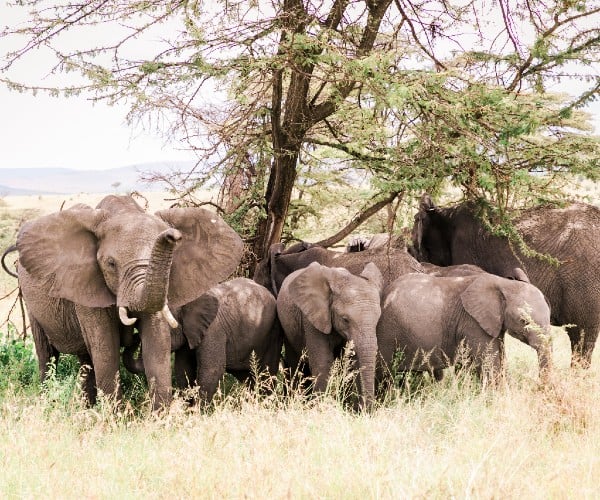 Elephants live in highly organised family groups, where strong social bonds are built under the guidance and leadership of the oldest female. The group is made up largely of the matriarch’s older female calves, other related females and their offspring; males leave the herd from the age of 12 years.
As a keystone species – or ‘ecosystem engineers’ – elephants play a very important role in shaping and protecting the natural environments in which they live. Removal of a keystone species from any major ecosystem leads to the severe imbalance and eventually collapse of the entire system. In various ways, elephants contribute to a healthy environment that provides vegetation for herbivores, which in turn feed predators and scavengers.
Elephants live in highly organised family groups, where strong social bonds are built under the guidance and leadership of the oldest female. The group is made up largely of the matriarch’s older female calves, other related females and their offspring; males leave the herd from the age of 12 years.
As a keystone species – or ‘ecosystem engineers’ – elephants play a very important role in shaping and protecting the natural environments in which they live. Removal of a keystone species from any major ecosystem leads to the severe imbalance and eventually collapse of the entire system. In various ways, elephants contribute to a healthy environment that provides vegetation for herbivores, which in turn feed predators and scavengers.
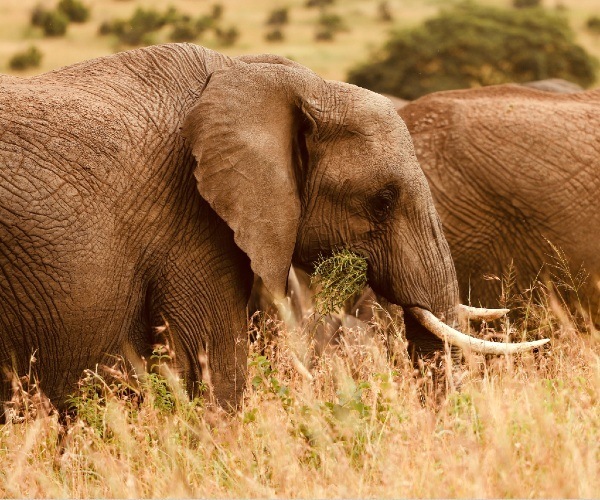 For instance, the survival of many plant species depends on their seeds passing through an elephant’s digestive tract before beginning the germination process. Elephants also maintain the grassland ecosystem by breaking and uprooting small bushes and trees that, if left to grow uncontrollably, would completely overtake important grassland ecosystems.
Lions – Cute cubs to big cat warriors
With their iconic mane of golden hair and adorable cubs, the lion has become symbolic of Africa and the ultimate Big 5 safari. But, beyond looking beautiful, the characteristic mane of a dominant adult male lion serves two important purposes. It helps protect the lion’s head and neck from injury, and deters rival males by making him appear larger and more intimidating. In fact, Kenya’s Maasai warriors have for centuries taken inspiration from these mighty beasts and wear feathered headdresses to appear taller and tougher.
For instance, the survival of many plant species depends on their seeds passing through an elephant’s digestive tract before beginning the germination process. Elephants also maintain the grassland ecosystem by breaking and uprooting small bushes and trees that, if left to grow uncontrollably, would completely overtake important grassland ecosystems.
Lions – Cute cubs to big cat warriors
With their iconic mane of golden hair and adorable cubs, the lion has become symbolic of Africa and the ultimate Big 5 safari. But, beyond looking beautiful, the characteristic mane of a dominant adult male lion serves two important purposes. It helps protect the lion’s head and neck from injury, and deters rival males by making him appear larger and more intimidating. In fact, Kenya’s Maasai warriors have for centuries taken inspiration from these mighty beasts and wear feathered headdresses to appear taller and tougher.
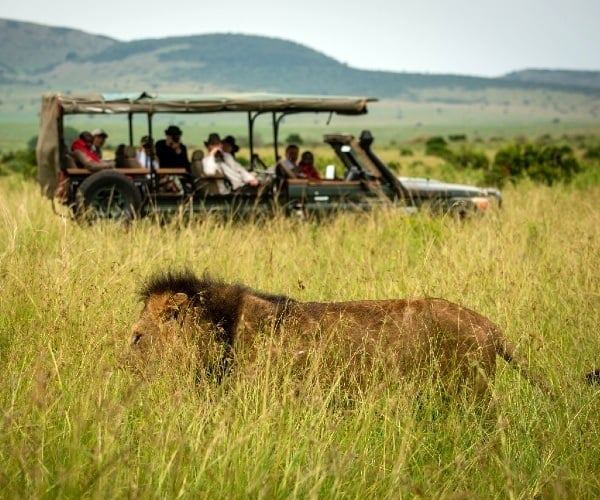 When food and water is plentiful, a lioness can give birth to a litter of up to five cubs every two years and usually all cubs in the pride will be born over the same time. Playtime for cubs is not only fun, it prepares them for adulthood when they will need to fight off threats and hunt prey successfully to survive.
When food and water is plentiful, a lioness can give birth to a litter of up to five cubs every two years and usually all cubs in the pride will be born over the same time. Playtime for cubs is not only fun, it prepares them for adulthood when they will need to fight off threats and hunt prey successfully to survive.
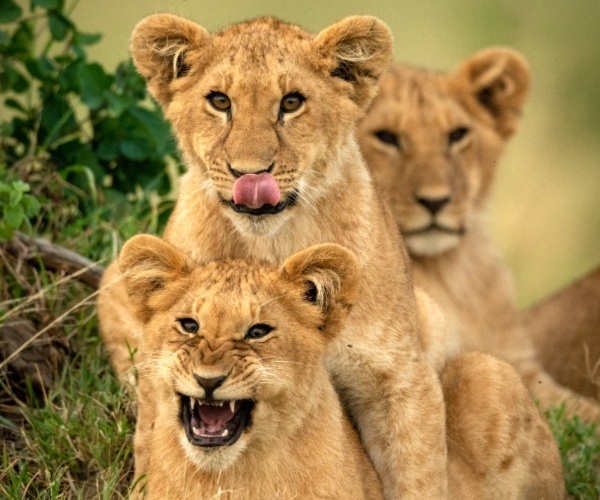 Because of their potential to grow into formidable hunters, other predators will attempt to kill young lion cubs if they find them alone and unguarded. Fortunately, lion mothers generally keep close watch of their little ones who are also naturally camouflaged by the colour and pattern of their coats.
Leopard – Africa’s lithe yet powerful felines
Considered Africa’s most agile and elusive big cat, spotting a leopard is made that much more exciting because they are so good at hiding, particularly during the day. While their feline dexterity and stealth make them excellent hunters because leopards are solitary animals, they are not afforded the protection that comes with living in a group, as lions do in a pride.
Because of their potential to grow into formidable hunters, other predators will attempt to kill young lion cubs if they find them alone and unguarded. Fortunately, lion mothers generally keep close watch of their little ones who are also naturally camouflaged by the colour and pattern of their coats.
Leopard – Africa’s lithe yet powerful felines
Considered Africa’s most agile and elusive big cat, spotting a leopard is made that much more exciting because they are so good at hiding, particularly during the day. While their feline dexterity and stealth make them excellent hunters because leopards are solitary animals, they are not afforded the protection that comes with living in a group, as lions do in a pride.
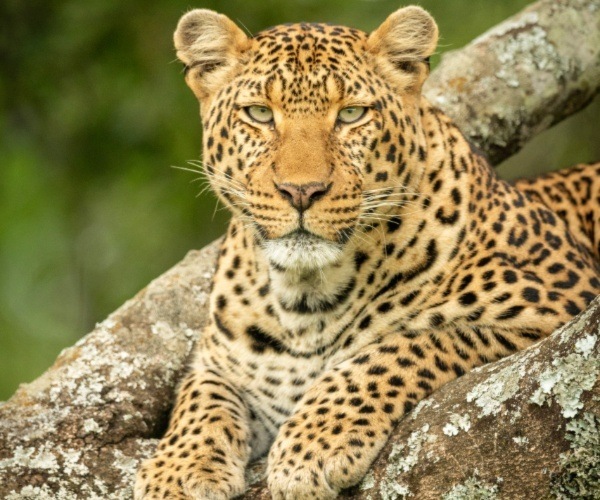 Having caught its prey, a leopard needs to drag it up into a tree in order to safeguard their bounty from theft by the likes of lions and hyenas. To climb skillfully like this, leopards have incredible upper body and forelimb strength, and can lift an animal of almost their own body weight into a tree.
Having caught its prey, a leopard needs to drag it up into a tree in order to safeguard their bounty from theft by the likes of lions and hyenas. To climb skillfully like this, leopards have incredible upper body and forelimb strength, and can lift an animal of almost their own body weight into a tree.
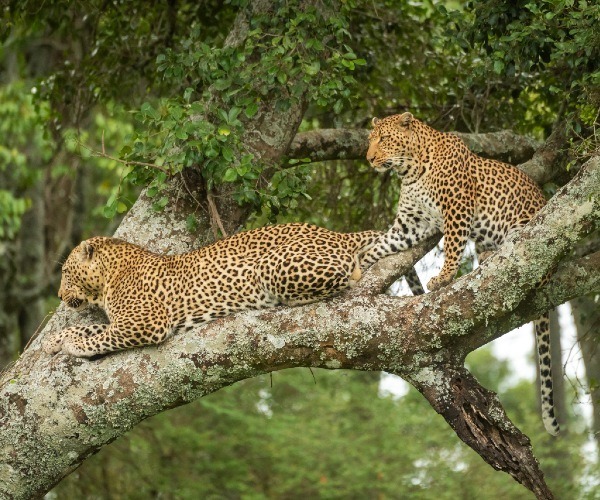 Unlike lions, which are the heaviest of the big cats, leopards can weigh up to just 90kgs for males and up to 60kgs for females. Also quite unlike lions, leopards are not afraid of getting wet and are, in fact, strong swimmers; they will even catch crabs and other aquatic creatures should the opportunity arise in a shallow lagoon.
Cape buffalo – Fearless herd defenders
Despite not being a predator, the large body and helmet of horns that characterise the Cape buffalo are what make it intimidating to the eye. This is backed up by its notoriously aggressive behaviour towards threats, even coming from large predators.
Unlike lions, which are the heaviest of the big cats, leopards can weigh up to just 90kgs for males and up to 60kgs for females. Also quite unlike lions, leopards are not afraid of getting wet and are, in fact, strong swimmers; they will even catch crabs and other aquatic creatures should the opportunity arise in a shallow lagoon.
Cape buffalo – Fearless herd defenders
Despite not being a predator, the large body and helmet of horns that characterise the Cape buffalo are what make it intimidating to the eye. This is backed up by its notoriously aggressive behaviour towards threats, even coming from large predators.
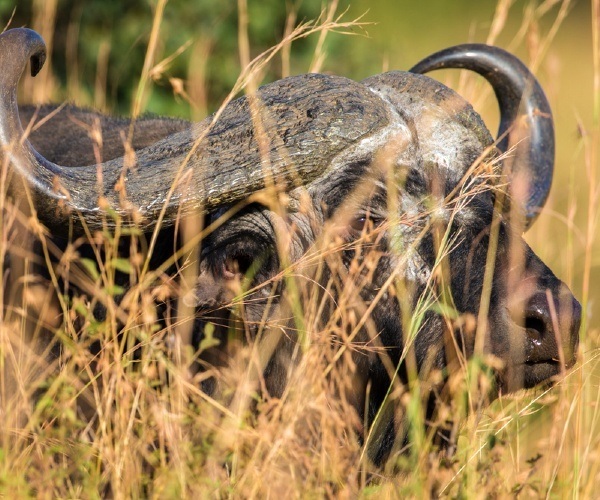 Often hunted by lions, buffalo demonstrate incredible loyalty to others in the herd and will try to rescue the member that is caught, by attacking the predator with its horns. When travelling, the herd will keep the younger and weaker members in the middle as a protective measure.
Often hunted by lions, buffalo demonstrate incredible loyalty to others in the herd and will try to rescue the member that is caught, by attacking the predator with its horns. When travelling, the herd will keep the younger and weaker members in the middle as a protective measure.
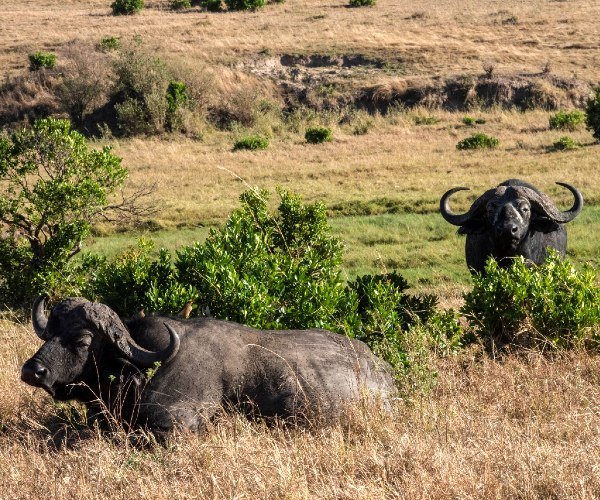 By eating large amounts of medium length grass, buffalo play a critical role in maintaining a functioning ecosystem as they reduce tall grasslands and open areas for antelope that feed on short grasses. Buffalo are good swimmers, crossing relatively deep water in search of better grazing land which they would have located using their excellent sense of smell. Being able to swim gives buffalo an advantage over lions, who avoid moving through water whenever possible.
White and black rhinos – Herbivores in armour
Africa is home to two of the world’s five rhino species; the other three are found in Asia. While their specie names are the white rhino and black rhino, the differences between the two has nothing to do with colour and everything to do with mouth shape.
By eating large amounts of medium length grass, buffalo play a critical role in maintaining a functioning ecosystem as they reduce tall grasslands and open areas for antelope that feed on short grasses. Buffalo are good swimmers, crossing relatively deep water in search of better grazing land which they would have located using their excellent sense of smell. Being able to swim gives buffalo an advantage over lions, who avoid moving through water whenever possible.
White and black rhinos – Herbivores in armour
Africa is home to two of the world’s five rhino species; the other three are found in Asia. While their specie names are the white rhino and black rhino, the differences between the two has nothing to do with colour and everything to do with mouth shape.
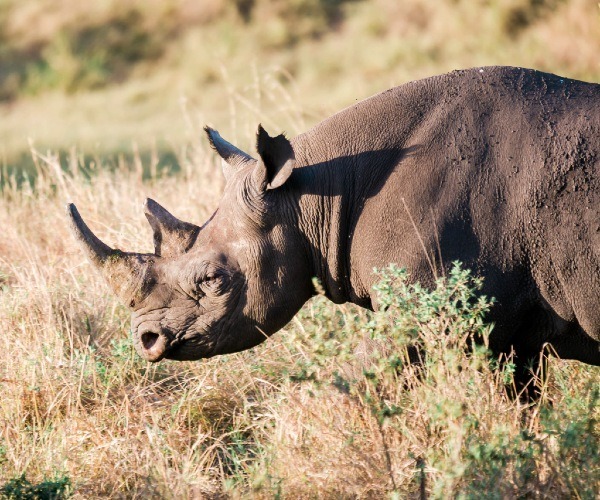 The white rhino has a wide, square shaped mouth and is the larger of the two species; in fact, it is the second largest animal in the world. The black rhino is identified by its hook shaped upper lip and has thick skin that forms plates over the shoulders, haunches, sides, legs and forehead.
It is always thrilling to see an animal from the Big 5. But don’t forget to pay attention to all the other fascinating creatures – large or small, feathered or scaly, noisy or silent – that Africa can show to the curious safari-goer.
Calvin Cottar is Director and Owner at Cottar’s 1920s Safaris. Cottar’s 1920s Safaris is an award-winning luxury 1920s safari camp and private bush villa located in the famous ‘seventh’ natural wonder of the world, the Maasai Mara in Kenya, and owned and managed by the oldest established and continuing safari family in Africa.
If you would like to be a guest blogger on A Luxury Travel Blog in order to raise your profile, please contact us.
The white rhino has a wide, square shaped mouth and is the larger of the two species; in fact, it is the second largest animal in the world. The black rhino is identified by its hook shaped upper lip and has thick skin that forms plates over the shoulders, haunches, sides, legs and forehead.
It is always thrilling to see an animal from the Big 5. But don’t forget to pay attention to all the other fascinating creatures – large or small, feathered or scaly, noisy or silent – that Africa can show to the curious safari-goer.
Calvin Cottar is Director and Owner at Cottar’s 1920s Safaris. Cottar’s 1920s Safaris is an award-winning luxury 1920s safari camp and private bush villa located in the famous ‘seventh’ natural wonder of the world, the Maasai Mara in Kenya, and owned and managed by the oldest established and continuing safari family in Africa.
If you would like to be a guest blogger on A Luxury Travel Blog in order to raise your profile, please contact us.Did you enjoy this article?
Receive similar content direct to your inbox.

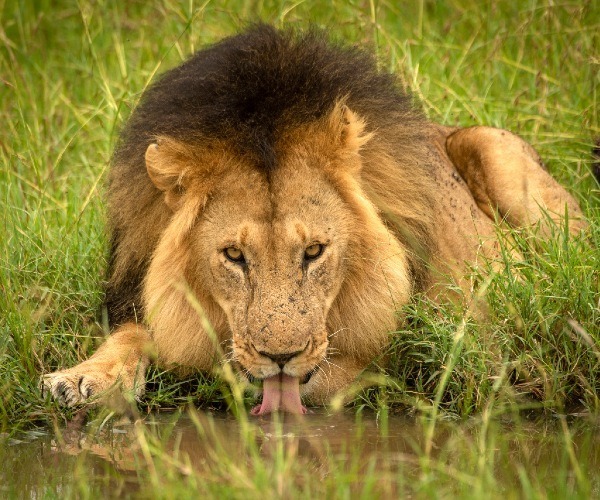

The final words of wisdom about not becoming too preoccupied with The Big Five are good advice. When you are on safari don’t forget to look up. You’ll be surprised at how many different species of birds are flying overhead.
When people visit us in the Mara with that Big 5 wish-list, they so often fall in love with other creatures, big and small, furry and feathery!
There must be something very satisfying about a safari where you’ve ticked all the boxes and seen the big five. I’ve never done it. It’s usually the rhinos who are quite elusive.
A wonderful feeling indeed, Gerald. Hopefully one day you’ll be able to tick them all of your wildlife wish-list – even a rhino!
Once a month through most of the lockdowns I’ve done Zoom calls with some long-lost friends. Of course we can’t help ourselves from talking about what we’re going to do when lockdown is finally over. Along with go to the hairdressers, hug my friends and book a restaurant table for 12 one of the long-term things that usually comes up is to go on a safari.
Don’t give up on that safari dream, Julia! There will come a time when travel will return and become part of all our lives again. Then, you’ll be able to have your safari experience in Africa. It’s definitely something to look forward to.
You make the point that it’s not just a matter of ticking off the Big Five, it’s also about seeing them in the their natural habitat and where they fit into the environmental scheme of things. After all you could go and see them in a zoo but a safari is about so much more than that.
Thanks Nick. It’s incredibly special to witness the Big 5 – and all wildlife, even the smallest – in the wilderness, where they’re meant to be.
It’s really amazing to see these wild animals in their natural habitat, the experience is surreal and I highly recommend it for those who love adventures and those who are thrill-seekers. I was afraid of the big cats, but ultimately it was one of my most unforgettable experiences.